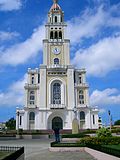| Catholic Church in Dominican Republic | |
|---|---|
| Iglesia Católica en República Dominicana | |
| Classification | Catholic |
| Orientation | Latin |
| Scripture | Bible |
| Polity | Episcopal |
| Governance | Episcopal Conference of the Dominican Republic |
| Pope | Leo XIV |
| President | Héctor Rafael Rodríguez Rodríguez |
| Language | Spanish, Latin |
| Headquarters | Santo Domingo |
| Origin | 1494 |
| Members | 6 million (2020) |
| Official website | Episcopal Conference of the Dominican Republic |
| Part of a series on the |
| Catholic Church by country |
|---|
 |
| |
The Catholic Church in the Dominican Republic is part of the worldwide Catholic Church, under the spiritual leadership of the Pope in Rome.
Contents
The Catholic Church is the world's largest Christian Church, and its largest religious grouping. There are an estimated 5 million Catholics in the Dominican Republic (48% of the population). [1] In 2020, just over 50% of Dominicans identified as Catholic, [2] served by 1,140 priests across 709 parishes. [3]








